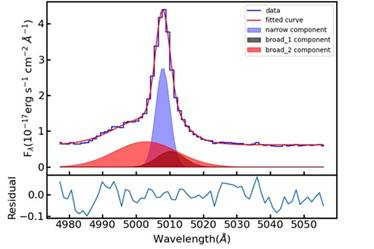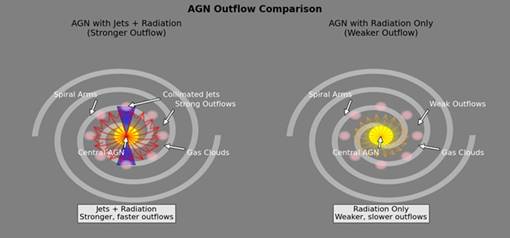Ministry of Science & Technology
Black holes and cosmic jets join forces to shape galaxies
प्रविष्टि तिथि:
21 OCT 2025 5:42PM by PIB Delhi
Black hole activities suppress the birth of new stars around it, shows a new study that can help in a deeper understanding of how galaxies evolve and may provide answers to why some have very low star-formation rates.
Supermassive black holes at the centres of galaxies are known to drive outflows of gas, and astronomers have long studied how feedback processes from these outflows can in turn determine the evolution of these galaxies. However, a key puzzle has been to understand the relative influence of this gas outflow versus radiation from the central regions on the behaviour and evolution of the host galaxy.
A new study led by astronomers at the Indian Institute of Astrophysics (IIA), an autonomous institute of Department of Science and Technology (DST) has uncovered key insights into these powerful forces shaping our Universe. Their study reveals that both the intense radiation from around the black holes, as well as the high-speed jets they emit, can work together to eject gas from the centers of galaxies, potentially shutting down star formation in their central regions and regulating galactic growth.
Using cutting-edge archival data from international astronomical facilities like the Sloan Digital Sky Survey (SDSS) Telescope at optical wavelengths and the Very Large Array (VLA) at radio wavelengths, both located in the United States, the researchers studied over 500 relatively nearby galaxies hosting active galactic nuclei (AGN). AGN are energetic galaxy centers that emit copious radiation and gas, powered by matter falling onto their supermassive black holes, many millions of times more massive than our Sun.
Payel Nandi, a Ph.D. student at IIA and the lead author of the study explains, “We found that outflows of warm ionized gas are widespread in AGN, and while radiation from the black hole is the main driver, galaxies with radio jets show significantly faster and more energetic outflows”.

Fig 1: Spectral signature of outflows
Their investigation further showed that such outflows, which are high-speed streams of gas pushed out from galactic centers, are more than twice as likely in galaxies detected in radio wavelengths (56%) compared to those without radio emission (25%). These powerful winds can travel at speeds of up to 2,000 kilometers per second, fast enough to escape the gravitational pull of the galaxy itself.
C. S. Stalin, a faculty member at IIA and a co-author of the study added, “This study emphasizes how vital it is to combine multi-wavelength data to understand the full picture of galaxy evolution.”
The researchers found a strong link between the energy of these outflows and the total luminosity / power generated by the supermassive black holes. In addition, for galaxies with radio jets, which are narrow collimated beams of relativistic particles launched from the vicinity of the supermassive black holes at nearly the speed of light, this link is even stronger. This suggests that jets, while not the primary cause, act like boosters that help eject even more gas.

Fig 2: A schematic illustrating how AGN with both jets and radiation drive stronger outflows compared to AGN powered only by radiation, leading to differing impacts on their host galaxies.
Dhruba J. Saikia, at the Inter-University Centre for Astronomy and Astrophysics, and co-author, said “These findings are an important step in understanding the complex inter-relationships between supermassive black holes, radio jets, star formation and evolution of their host galaxies.”
The team also found that due to the outflows in these galaxies, star formation is almost completely shut down in the central regions. The study used optical measurements of stellar populations and infrared color diagnostics to confirm that black hole activity, and not star formation, is driving the winds. This points to a phenomenon called negative AGN feedback, where black hole activities suppress the birth of new stars around it.
The study published in The Astrophysical Journal. gives us a deeper understanding of how galaxies evolve and why some have very low star-formation rates. It shows that even objects as distant and mysterious as supermassive black holes can have a big impact on shaping our Universe.
******
NKR/AK
(रिलीज़ आईडी: 2181299)
आगंतुक पटल : 2441